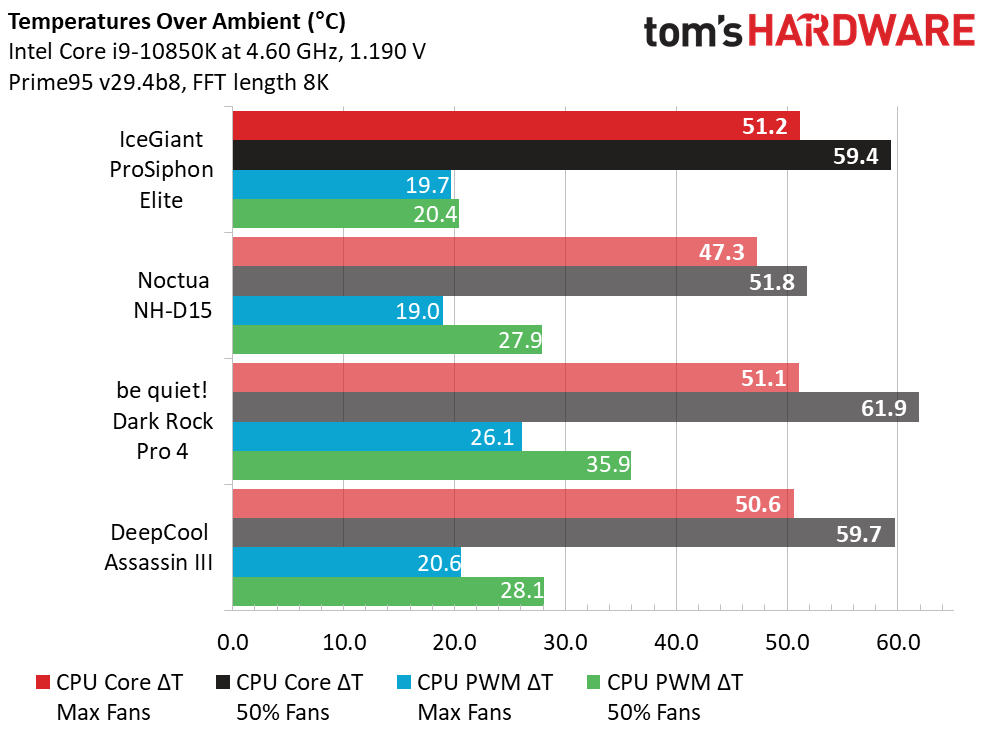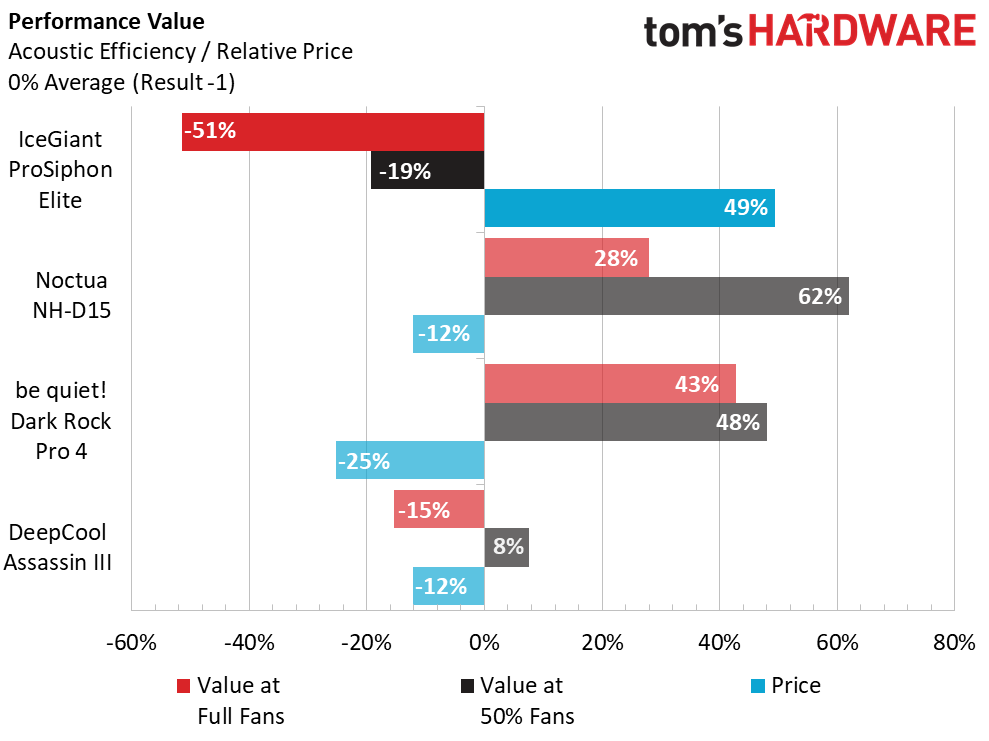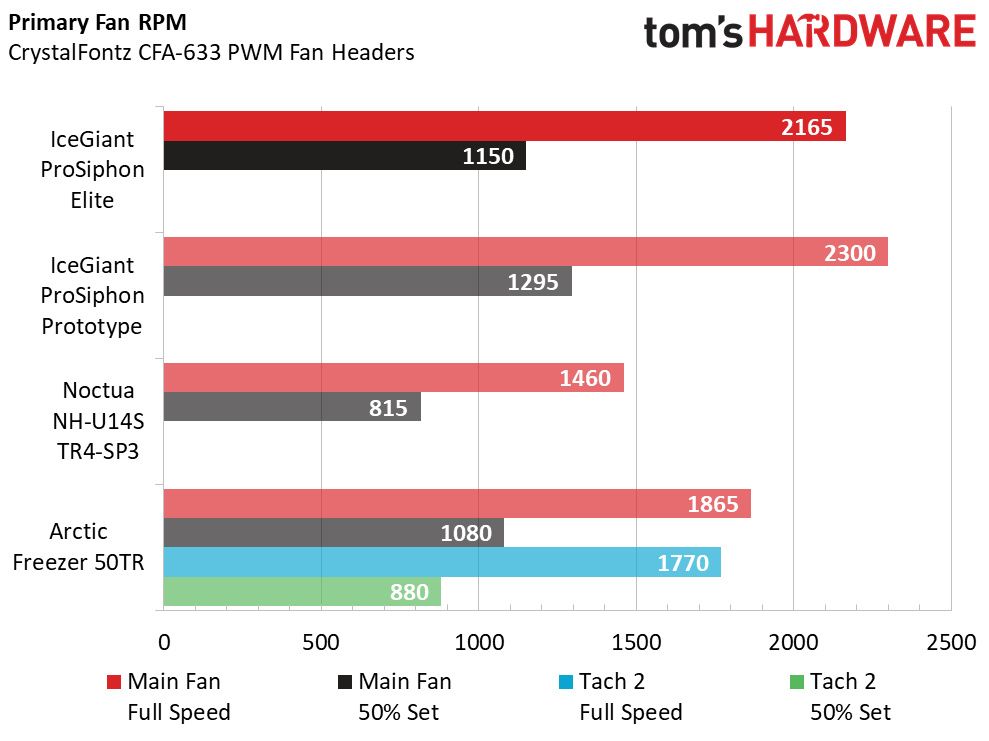Why you can trust Tom's Hardware
Testing Results
The IceGiant ProSiphon Elite runs neck and neck with some of the best large heatpipe coolers we’ve tested. Overall size and efficiency are put to the test with a quartet of some of the largest, premium air cooling systems available today.
The IceGiant ProSiphon Elite makes use of four (4) 120mm fans while the remaining coolers make use of 135mm or larger fans, and at most two per unit.
While most large air coolers benefit from large, slow-spinning fans to achieve low noise levels, the IceGiant ProSiphon Elite sees higher registered noise levels with its setup of four 120mm fans.
With very close thermal load results, the differences in noise levels creates some waves in the overall shift of acoustic efficiency. Larger fans that operate more quietly will offer a larger benefit over louder/faster versions.
All things being relatively equal, the retail price of the IceGiant ProSiphon Elite at $170 creates a larger gap between it and other premium air offerings in terms of evaluating performance value.
We couldn’t resist comparing the retail version of the IceGiant ProSiphon Elite and its prototype as well as some other high-performance Threadripper solutions. And this seems to be where the icy best shines. The IceGiant ProSiphon gives us the most thermal headroom on our steamy 2990WX.
Fan speeds between the two IceGiant versions are minor, although each use different fan models, accounting for the differences.
Get Tom's Hardware's best news and in-depth reviews, straight to your inbox.
Those small fan differences make a substantial difference between the prototype and retail versions of the IceGiant ProSiphon Elite, although it's still not as quiet as the Noctua NH-U14S TR4-SP3 or Arctic Freezer 50TR.
Even though the IceGiant produced the lowest load temperatures, the noise levels produced by the cooling fans cause a swing in acoustic efficiency to tip the scales a bit in favor of the quieter coolers.
Conclusion
Again, the retail price of $170 causes the IceGiant to slip in overall performance value, but does provide the best thermal results of any cooler we’ve tested on our Threadripper platform to-date.

Thermal imaging from our FLIR ONE Pro camera shows a noticeable difference of heat soak across the primary body of the heat exchanger when fans operate at 50% PWM on our Intel i9-10850k system. By comparison, a cloud of warmer exhaust air can be seen above the IceGiant ProSiphon Elite due to the additional heat buildup.
Taking some thermal observations with the FLIR ONE Pro on the Threadripper 2990WX shows a similar result, although subtle differences exist between the 100% and 50% between AMD and Intel load testing. The AMD system looks to stress the cooler overall more than the Intel testing intervals. This cooler is arguably overkill for anything other than HEDT platforms, unless perhaps you're aiming for the highest possible sustained overclocks on a mainstream Core i9 CPU.
The IceGiant ProSiphon Elite is derived from years of industrial thermal solutions, with a new focus in the performance desktop PC marketplace. It sits just at the bleeding edge of current cooling technology. While most enthusiasts and power users would opt for a traditional heatpipe or AIO liquid cooler, the IceGiant provides an interesting, well-performing third option other than premium AIOs and premium large heatpipe cooling.

Garrett Carver is a contributor for Tom’s Hardware, primarily covering thermal compound comparisons and CPU cooling reviews; both air and liquid, including multiple variations of each.
-
Lord Tyrion Outperformed on the i9 by the Noctua and barely better on the Threadripper, but twice the price, huge and loud! Not sure why you'd pay the extra over a Noctua or less for a regular water AIO. Strange conclusion imo.Reply -
punkncat It's all fun and games until the weight of that ruins traces/lanes around your CPU. Motherboards aren't made for holding weight like that.Reply -
helper800 Reply
What this does outperform all traditional air coolers on is sustained cooling. There is so much more mass to transfer heat, coupled with a better method of exchanging heat leads to much longer heat soak times which means significantly longer sustained boost frequencies.Lord Tyrion said:Outperformed on the i9 by the Noctua and barely better on the Threadripper, but twice the price, huge and loud! Not sure why you'd pay the extra over a Noctua or less for a regular water AIO. Strange conclusion imo. -
rubix_1011 The majority of the evaluation is relative to existing solutions. Also, stop to consider that this is a new cooling technology to the performance/desktop PC space in terms of utilization. Similar to heatpipes but with a potentially larger overhead.Reply
You are correct - it's incredibly difficult to beat the Noctua NH-D15, even though its an older cooler. It shows you how good it is and why EVERYONE is quick to recommend it if you can fit it into a case (and budget). It is also still $100, so again, we're looking at a market segment where someone is already spending large sums of money and 'wants to know what else is out there'. Not everyone wishes to opt for the same cooler just because it's been the benchmark for like....forever. This is also the same reason we have millions of flavors of ice cream, different car models in the same classification and why your local Foot Locker sells Nike, as well as Adidas .
Also have to consider that opinion is not the same as fact. Perspective is everything, and that all depends on your budget and goals. There is a huge trend in internet searches and inquiry about 'what is the best' (intersect of 'x', for example) when in fact, the question is 'what is the best but for minimal budget', making these types of questions not one of just being 'best' but also of 2-axis of evaluation ('X' against 'Y'). This does not apply to all, nor does it apply to all as a constant in every situation.
In terms of Threadripper usage - let's take for example our test system of a 2990WX and Gigabyte Aorus X399 Xtreme: The CPU is nearly $1900 alone. The motherboard is nearly $880. These are today's prices - March 31, 2021. High end TR4 system builders spending $2600+ on CPU/MB and would rather not have an AIO have options of only a real solid handful of powerful air-cooling options.
The IceGiant is large, but in terms of how large it is vs. the NH-D15, the IceGiant is more rectangular while the Noctua is more 'square' overall. Both are still huge.
And yes - it is heavy. By design it is significantly well-built and to be industrial-esque overall due to the roots of the parent company - one in which they've been applying this tech to large/heavy industrial and commercial machinery for quite some time. The prototype I tested was even larger (link to that is also listed) in the first paragraph. Always remember that there are backplates which distribute stress as well as the possibility that you can opt to have the motherboard horizontal if you'd prefer. No one is 'forcing' anyone to use a traditional/vertical case.
For noise - having a 360 AIO running fans at 100% can get pretty noisy, I have experienced this a lot in testing coolers over the past 4 years. This is why PWM curving is very important if you want to control noise levels. -
g-unit1111 Seriously, just buy a 280mm at that point, there's absolutely no need for this thing. It's bested by a tried and true cooler (the D15) and 280mm coolers aren't that much more expensive. Like... what's the point of this thing?Reply -
mdd1963 Clearly, spreading the stacks out sideways is of little consequence just yet, based on not even meeting D15's cooling capabilities....Reply -
Jake Hall Running it on my 5900x and I'm happy with the performance so far, but I also haven't pushed the CPU for extended periods and it's not summertime yet. It really should have copper, instead of an aluminum contact. I got it for $120 and I hope to see more from the company.Reply -
Phaaze88 Oh yeah, I was waiting to see the review of this thing here - I'd already seen the review over at Kitguru.Reply
Looks like the same result: This cooler can't really stretch its legs at anything below HEDT. -
deesider Reply
Except that is not what is shown in the results for the i9. The results were from running Prime95 for two hours, during which the Noctua had significantly lower temps. Nothing to suggest that the Ice Giant would get better boost frequencies. That could be possible, but not from these results.helper800 said:What this does outperform all traditional air coolers on is sustained cooling. There is so much more mass to transfer heat, coupled with a better method of exchanging heat leads to much longer heat soak times which means significantly longer sustained boost frequencies.
The Threadripper temps were higher on the Noctua due to saturating the heatpipes. That could be overcome by using thicker heatpipes; then the cooling is effectively limited by the ability of the fans to eliminate the heat. That can be achieved without all the extra weight of the Ice Giant. -
HideOut Replyg-unit1111 said:Seriously, just buy a 280mm at that point, there's absolutely no need for this thing. It's bested by a tried and true cooler (the D15) and 280mm coolers aren't that much more expensive. Like... what's the point of this thing?
Most 280's and 360's are cheaper, especially on sale. Im confused as to why the Darkrock pro was on part of the review then disapeared. That thing is $85 at newegg today in fact.










